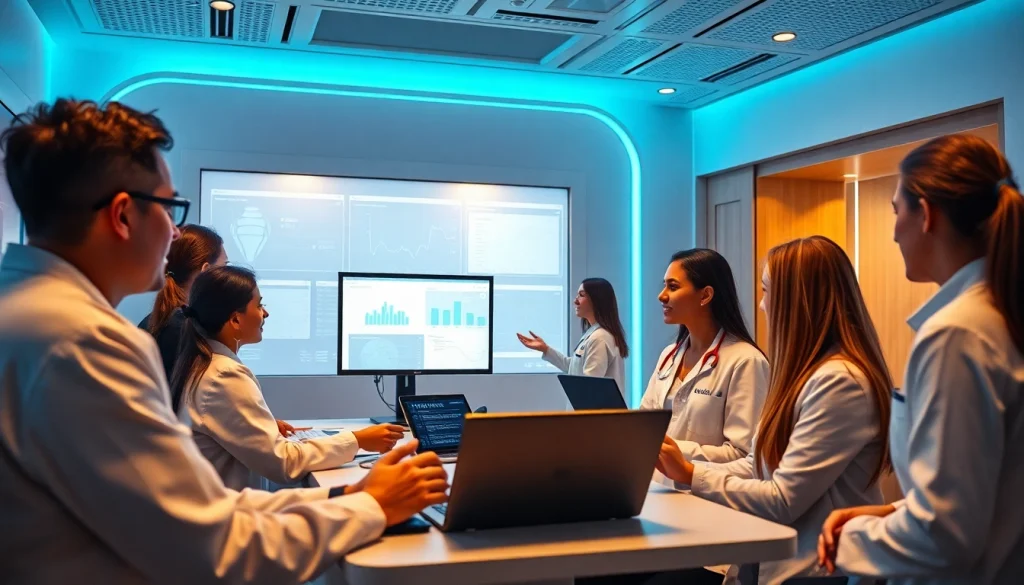
Understanding Informatics in Healthcare
As healthcare continues to evolve, the integration of technology and data management has become paramount. The concept of health informatics merges various disciplines—ranging from information science to decision-making processes—to improve the quality of patient care. At the forefront of this integration is www.informaticsview.com, which serves as a pivotal resource for professionals navigating this complex yet essential field.
Defining Informatics and Its Importance
Informatics can be succinctly defined as the science of using data, information, and knowledge to improve human health and the delivery of healthcare services. As described by the American Medical Informatics Association (AMIA), it encompasses the application of technology to manage health data effectively, making it vital for informing clinical decisions. Health informatics not only aids in the collection and analysis of health data but also plays a crucial role in translating that data into actionable insights for healthcare practitioners.
Key Areas of Application
The applications of health informatics span various domains, including:
- Electronic Health Records (EHRs): Digital records facilitate swift access to patient information, allowing healthcare providers to offer more coordinated and efficient care.
- Clinical Decision Support Systems (CDSS): These systems leverage data to assist healthcare professionals in making informed decisions, thereby enhancing the quality of care.
- Telehealth Services: Informatics enables remote consultation and monitoring, ensuring that patients receive care in a timely manner, even from a distance.
- Health Information Exchanges (HIEs): Interoperability is a key focus, allowing healthcare entities to share patient data seamlessly, ultimately improving the continuity of care.
- Patient Portals: Empowering patients to access their health information and engage in their healthcare journey is an increasingly important aspect of health informatics.
Challenges Faced by Healthcare Professionals
Despite its vast potential, the integration of informatics in healthcare is fraught with challenges. These include:
- Data Privacy and Security: Ensuring patient data confidentiality amidst growing cybersecurity threats is a pressing concern.
- Interoperability Issues: The lack of standardization among different EHR systems often hinders seamless data exchange.
- Training Needs: Healthcare professionals require adequate training to effectively utilize informatics tools, which can sometimes be a barrier to implementation.
- Resistance to Change: Cultural barriers within healthcare organizations can impede the adoption of new technologies, with some staff preferring traditional methods.
Core Components of Health Informatics
Technological Tools in Healthcare
Informatics encompasses a variety of technological tools designed to support healthcare delivery. Key tools include:
- Data Analytics Software: Tools like Tableau and SAS facilitate the analysis of complex data sets, enabling healthcare organizations to derive actionable insights.
- Patient Management Systems: Systems that streamline appointments, billing, and patient communications enhance operational efficiency within healthcare facilities.
- Wearable Health Technology: Devices that monitor health parameters in real-time contribute to preventative care and ongoing patient management.
- Artificial Intelligence: AI algorithms can assist in diagnostics, predicting patient outcomes based on historical data and treatment responses.
Data Management Strategies at www.informaticsview.com
Effective data management is a cornerstone of health informatics. Key strategies include:
- Data Standardization: Implementing consistent data formats and protocols improves interoperability among systems.
- Data Governance: Establishing clear policies on data usage, compliance, and privacy fosters trust and security among patients and providers alike.
- Regular Audits: Conducting audits of data collection and management practices ensures adherence to best practices and addresses any discrepancies.
Real-World Applications and Case Studies
Examining real-world applications of informatics can highlight its transformative potential:
- Case Study 1: A large urban hospital implemented a CDSS, leading to a 20% reduction in medication errors over one year.
- Case Study 2: A rural healthcare facility adopted telehealth services that increased patient consultations by 40%, enabling better access to care for underserved populations.
Current Trends and Innovations
Emerging Technologies in Informatics
As the field of health informatics continues to advance, several key trends and innovations are shaping its future:
- Blockchain Technology: Starting to gain traction for ensuring data integrity and security in patient records.
- Predictive Analytics: Leveraging big data to forecast health trends and individual patient risks, allowing for proactive care.
- Mobile Health Applications: Increasingly popular for chronic disease management and improving patient engagement.
Impact of Artificial Intelligence
AI is revolutionizing health informatics by:
- Enhancing Diagnostics: AI algorithms can analyze medical images with high accuracy, assisting radiologists in identifying anomalies.
- Personalizing Treatment Plans: AI systems can recommend tailored interventions based on individual patient profiles and historical data.
- Streamlining Administrative Tasks: Automating routine tasks frees healthcare professionals to focus on patient care rather than paperwork.
Future Predictions for Healthcare Informatics
Experts predict that informatics will play a pivotal role in shaping the future of healthcare, with expected developments including:
- Increased Patient Engagement: More robust platforms for patient interactions, facilitated by mobile technology and AI, will improve health outcomes.
- Greater Interoperability: The push for standardization and unified protocols across platforms will enhance data sharing.
- Focus on Preventive Care: By utilizing analytics to identify at-risk patients, healthcare systems can shift toward prevention rather than reactive care.
Best Practices for Implementation
Steps to Integrate Informatics Solutions
The integration of informatics solutions requires careful planning and execution. Key steps include:
- Assessment of Needs: Understand the specific needs of the organization and its stakeholders to select appropriate tools.
- Engagement of Staff: Involve end-users from the outset to gather insights and foster acceptance of new technologies.
- Testing and Feedback: Pilot the chosen solutions before full-scale implementation to gauge effectiveness and address concerns.
- Ongoing Support: Provide continuous support and resources to staff during and after the deployment of informatics solutions.
Training Healthcare Teams Effectively
A robust training program is essential for the success of informatics initiatives:
- Comprehensive Training: Develop training sessions that cater to different learning styles, including hands-on practice and theoretical concepts.
- Ongoing Education: Establish continuous learning opportunities through workshops, webinars, and easy access to updated resources.
- Mentorship Programs: Pair less experienced staff with seasoned professionals to foster knowledge transfer and build confidence.
Measuring Success Metrics
To assess the effectiveness of informatics implementations, organizations should focus on measurable outcomes:
- Patient Satisfaction Scores: Evaluate patient feedback post-implementation to determine the impact of new solutions.
- Operational Efficiency: Monitor changes in workflow and productivity to gauge improvements in care delivery.
- Clinical Outcomes: Review patient health outcomes pre- and post-implementation to measure the effectiveness of informatics tools.
Resources and Support
Recommended Readings and Tools
Enhancing knowledge in health informatics requires continual learning. Recommended resources include:
- Books such as Health Informatics: A Systems Perspective which explores the conceptual frameworks within the field.
- Online courses from reputable institutions like Coursera and edX, focusing on data analytics and health informatics.
- Professional journals like the International Journal of Medical Informatics that publish cutting-edge research and case studies.
Communities and Organizations
Joining professional communities can provide valuable networking and support:
- American Medical Informatics Association (AMIA): A prominent organization that offers resources, networking, and advocacy for health informatics professionals.
- Health Information Management Systems Society (HIMSS): A larger organization focused on better health through information technology.
Further Learning Opportunities
Engaging with further learning opportunities helps stay abreast of innovations in informatics:
- Conferences such as the HIMSS Global Health Conference & Exhibition, where professionals can learn and network.
- Webinars hosted by various health organizations focusing on emerging topics in informatics.
- Online forums and discussion groups centered around specific health informatics topics.






